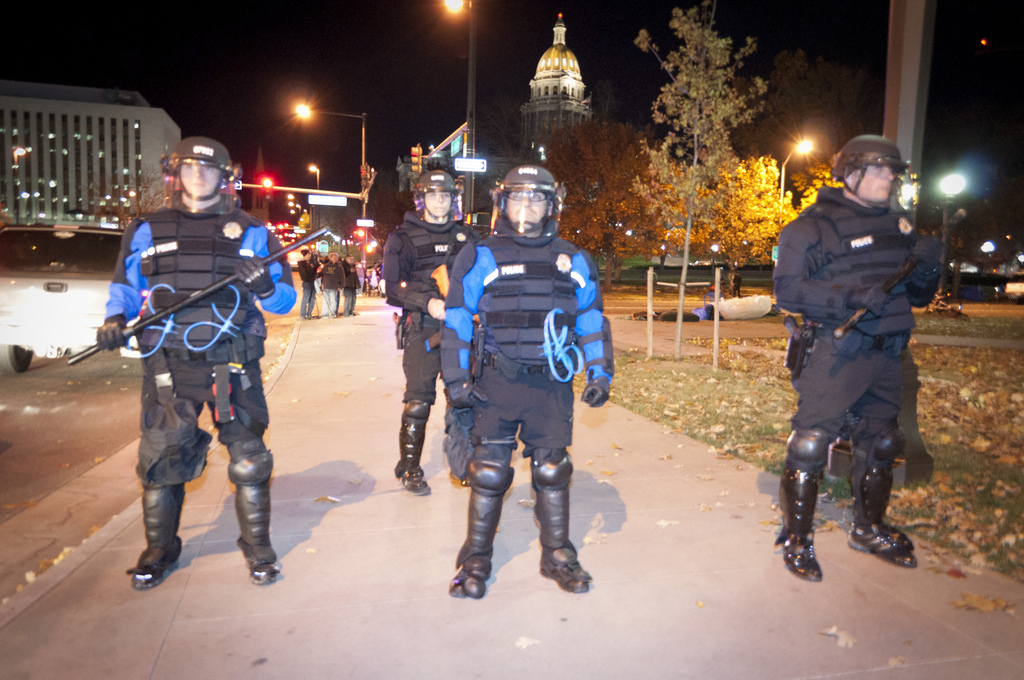Originally published at MintPress News.
DENVER — A leaked police manual reveals how Denver police respond to marches and other forms of protest, including their use of undercover “platoons” of officers to pick out leaders for later arrest.
On Jan. 19, Unicorn Riot, an independent media collective with several members in the state, published a heavily redacted version of the 2011 edition of the “Denver Police Department Crowd Management Manual” obtained through a Colorado Open Records Act request. Days later, an anonymous source sent them an unredacted copy of the 2008 edition of the manual. The two editions appear to have few differences and the policies described in both versions match the behavior of police toward protests, according to activists and journalists interviewed by MintPress News.
“This manual has been a tremendous help to our reporting in terms of understanding the police apparatus that is deployed at protests,” representatives of Unicorn Riot told MintPress by email.
Read the 2008 Denver Police Department Crowd Management Manual:
[scribd id=297998469 key=key-EtSvKrCevK8r0LdojAYr mode=scroll]
Both editions of the manual provide guidelines for handling both planned and spontaneous protests while maintaining that “all police personnel will ensure minimal disruption to First Amendment activities.”
However, they provide little guidance to help officers differentiate between protected speech and unlawful behavior. “This talking point and any other mention of the ‘First Amendment’ by the police seems to just be public relations,” Unicorn Riot noted in the email, adding that Denver police regularly target activists who speak out against the police, even if their behavior is law-abiding.
“Appendix A” in both versions of the manual lists local laws which police might use for arrests during a protest. The Unicorn Riot representatives said these charges, such as obstruction of streets, are selectively used against activists that confront police officers. “In the last year, protest arrestees are also being hit with false assault charges, which tend to be quickly dropped,” they added.
The unredacted manual even outlines the use of “Shadow Teams,” groups of undercover officers that follow a protest and identify its leaders so that they can be arrested later by “Arrest Teams.” Unicorn Riot representatives said police frequently target “people who look like anarchists, aka dressed in black.”
James Rotten, an anti-police brutality activist who asked to use a pseudonym out of fear of reprisal for his statements, concurred, noting: “We will have done a 200-person march in the street and then, as they’re leaving, they pick out six people to arrest.”
He cautioned that these arrestees are not always protest leaders or organizers. “It might be someone who is particularly vocal.”
Representatives for Unicorn Riot also told MintPress that those who yell “fuck the police” during an event are often among those targeted later, even though this is constitutionally-protected free speech.
Another revealing portion of the unredacted manual notes that officers may use “pain compliance” techniques against passively resisting, nonviolent protesters. “It is common for people arrested at protests in Denver to report that while being arrested, officers pulled and twisted their wrists and fingers in very painful ways both as they are being handcuffed, and after they have already been handcuffed,” Unicorn Riot reported on its website.
Newly leaked charts also detail when police can use “less lethal” crowd control weapons. However, these guidelines often break down during tense or chaotic interactions between activists and police. Unicorn Riot told MintPress: “The only way the manual does not conform to our direct experiences is the calm, orderly picture of police behavior it presents — things get pretty hectic pretty fast and individual cops definitely take liberties.”
Although the manual forbids firing “pepper balls” directly at someone’s face, during an Oct. 29, 2011 incident, “just a few weeks after the most recent update to the crowd control manual, Denver Police shot a man at Occupy Denver in the face with a pepper ball gun, taking a chunk out of his nose,” Unicorn Riot told MintPress.
Rotten noted that while the document accurately reflects police behavior he’s observed in the field, it’s “chilling” to see it described so bluntly in the leak. Unicorn Riot representatives agreed:
It described in detail things many of us have witnessed or directly experienced. Nothing came as a surprise, although seeing some of it in writing did feel kind of strange at first.
They added that the manual leaks have the potential to influence Denver’s activists, the journalists who write about them, and even the police:
In a lot of ways it told us what we already knew, but the specific terminology used will help us in crafting future open records requests. While it is too soon to say, we could see the release of this manual precipitating an evolution in tactics used by protesters, and perhaps also by police, who may try to introduce new tactics to replace those that are now in the public domain.
Watch “Occupy Denver Police Violence Man Shot in Face With Pepper-balls” from WACCTV:
